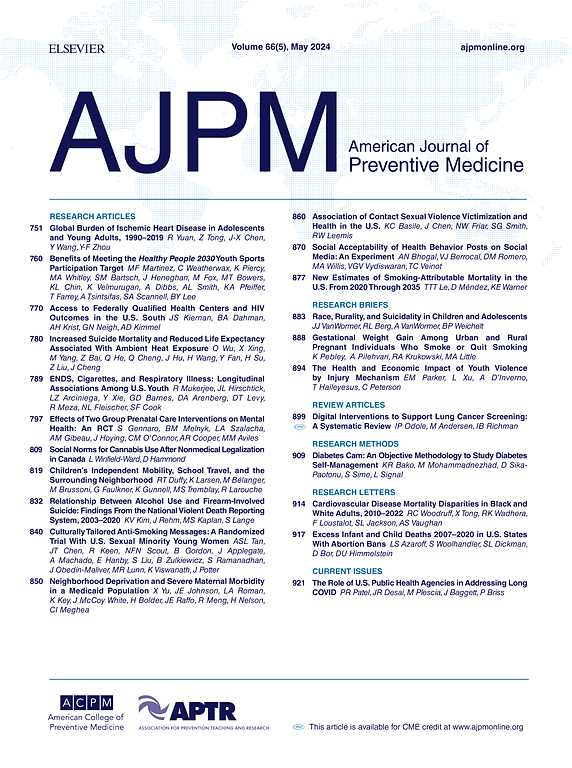Awareness and Use of MyPlate Among U.S. Adults: Evidence From Nationally Representative Data, 2024
IF 4.5
2区 医学
Q1 MEDICINE, GENERAL & INTERNAL
引用次数: 0
Abstract
Introduction
USDA’s current nutrition guide—MyPlate—was introduced in 2011 to promote the Dietary Guidelines for Americans and make it easier for U.S. consumers to follow balanced eating habits. This study estimates the share of U.S. adults who report knowing about the MyPlate plan and trying to follow its recommendations, and identifies the consumer characteristics that predict use of the MyPlate plan.
Methods
Using a nationally representative sample of 5,930 U.S. adults aged 18 and older from the 2024 Health Information National Trends Survey (HINTS), an ordered probit regression model was estimated to predict MyPlate plan use. The 2024 HINTS data were publicly released in May 2025 and these public-use and de-identified data were analyzed in June 2025.
Results
In 2024, nearly 1 in 3 U.S. adults (32.5%; 95% CI=30.6%, 34.4%) reported knowing about the MyPlate plan. However, fewer than half of them translated this knowledge into practice, as only about 1 in 7 U.S. adults (14.8%; 95% CI=13.2%, 16.3%) reported knowing about and trying to follow MyPlate plan recommendations. The likelihood of trying to follow MyPlate guidance was significantly higher among young adults aged 18–24 years, women, households with children, English survey respondents, and metropolitan area residents.
Conclusions
Approximately 15% of U.S. adults in 2024 reported that they knew about the MyPlate plan and tried to follow its recommendations. Age group, sex, number of children, survey language, and residential location influenced the likelihood of trying to follow MyPlate guidance.
美国成年人对“我的餐盘”的认识和使用:来自2024年全国代表性数据的证据
简介:美国农业部目前的营养指南“我的餐盘”于2011年推出,旨在推广美国人的饮食指南,使美国消费者更容易遵循均衡的饮食习惯。这项研究估计了了解“我的餐盘”计划并试图遵循其建议的美国成年人的比例,并确定了预测使用“我的餐盘”计划的消费者特征。方法:使用来自2024年健康信息全国趋势调查(HINTS)的5930名18岁及以上的美国成年人的全国代表性样本,估计一个有序概率回归模型来预测我的餐盘计划的使用。2024提示数据于2025年5月公开发布,这些公共使用和去识别的数据于2025年6月进行了分析。结果:2024年,近三分之一的美国成年人(32.5%,95% CI = 30.6%,34.4%)报告了解MyPlate计划。然而,只有不到一半的人将这些知识转化为实践,因为只有七分之一的美国成年人(14.8%,95% CI = 13.2%,16.3%)报告了解并试图遵循我的餐盘计划建议。在18-24岁的年轻人、女性、有孩子的家庭、英国受访者和大都市区居民中,遵循“我的餐盘”指导的可能性要高得多。结论:2024年,大约15%的美国成年人报告说,他们知道“我的餐盘”计划,并试图遵循其建议。年龄组、性别、儿童数量、调查语言和居住地点影响了尝试遵循“我的餐盘”指导的可能性。
本文章由计算机程序翻译,如有差异,请以英文原文为准。
求助全文
约1分钟内获得全文
求助全文
来源期刊

American Journal of Preventive Medicine
医学-公共卫生、环境卫生与职业卫生
CiteScore
8.60
自引率
1.80%
发文量
395
审稿时长
32 days
期刊介绍:
The American Journal of Preventive Medicine is the official journal of the American College of Preventive Medicine and the Association for Prevention Teaching and Research. It publishes articles in the areas of prevention research, teaching, practice and policy. Original research is published on interventions aimed at the prevention of chronic and acute disease and the promotion of individual and community health.
Of particular emphasis are papers that address the primary and secondary prevention of important clinical, behavioral and public health issues such as injury and violence, infectious disease, women''s health, smoking, sedentary behaviors and physical activity, nutrition, diabetes, obesity, and substance use disorders. Papers also address educational initiatives aimed at improving the ability of health professionals to provide effective clinical prevention and public health services. Papers on health services research pertinent to prevention and public health are also published. The journal also publishes official policy statements from the two co-sponsoring organizations, review articles, media reviews, and editorials. Finally, the journal periodically publishes supplements and special theme issues devoted to areas of current interest to the prevention community.
 求助内容:
求助内容: 应助结果提醒方式:
应助结果提醒方式:


